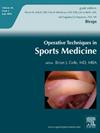Lateral Extra-Articular Tenodesis in the Young Athlete: Can We Reduce the Risk of Re-Injury?
IF 0.7
4区 医学
Q4 SPORT SCIENCES
引用次数: 0
Abstract
Graft rupture following ACL reconstruction is 1 of the major concerns for both patients and providers. Young athletes are the group with the highest risk for reinjury due to the demand they place on the reconstructed ACL. As a result, much consideration has been directed toward reducing the risk of graft rupture. Lateral extraarticular tenodesis (LET) is an adjunct procedure performed along with ACL reconstruction in an attempt to reduce the risk of reinjury. During this procedure, an additional soft tissue structure is constructed on the lateral portion of the knee to reduce residual rotatory instability, which is considered a risk factor for ACL graft rupture. This procedure has been shown in both pediatric and adult cohorts to significantly reduce reinjury rates and has been incorporated into the practice of many pediatric orthopedic surgeons. However, variation exists in the indications for LET, and concerns regarding the addition of a nonanatomical structure to the knee remain, making some surgeons hesitant to adopt this procedure. Promising findings suggest that LET is a strong option to reduce the risk of ACL graft rupture with low risk for additional complications, but more research is necessary regarding this procedure, particularly in pediatric cohorts.
年轻运动员的外侧关节外肌腱固定术:我们能降低再次受伤的风险吗?
前交叉韧带重建后移植物破裂是患者和医生主要关注的问题之一。由于年轻运动员对重建的前交叉韧带的需求,他们是再损伤风险最高的群体。因此,减少移植物破裂的风险已成为人们关注的焦点。外侧关节外肌腱固定术(LET)是与前交叉韧带重建一起进行的辅助手术,旨在降低再损伤的风险。在此过程中,在膝关节外侧部分建立一个额外的软组织结构,以减少残留的旋转不稳定,这被认为是ACL移植物破裂的危险因素。该手术已在儿童和成人队列中被证明可以显著降低再损伤率,并已被许多儿童骨科医生纳入实践。然而,LET的适应症存在差异,并且对膝关节增加非解剖结构的担忧仍然存在,这使得一些外科医生对采用该手术犹豫不决。有希望的研究结果表明,LET是一种强有力的选择,可以降低前交叉韧带移植破裂的风险,并降低其他并发症的风险,但需要更多的研究,特别是在儿科队列中。
本文章由计算机程序翻译,如有差异,请以英文原文为准。
求助全文
约1分钟内获得全文
求助全文
来源期刊
CiteScore
0.60
自引率
0.00%
发文量
46
审稿时长
93 days
期刊介绍:
Operative Techniques in Sports Medicine combines the authority of a textbook, the usefulness of a color atlas and the timeliness of a journal. Each issue focuses on a single clinical condition, offering several different management approaches. It''s the easiest way for practitioners to stay informed of the latest surgical advancements and developments.

 求助内容:
求助内容: 应助结果提醒方式:
应助结果提醒方式:


